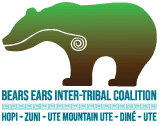okai Dome is a vast area of naked sandstone, sparse pinon/juniper forests and blackbrush just east of the Glen Canyon National Recreation Area. This rugged and lonely land is host to numerous deep canyons, bare slickrock, and breathtaking views of the Waterpocket Fold of Capitol Reef National Park, Navajo Mountain (a sacred peak known to Navajo people as Naatsisʼáán), as well as the Henry and Little Rockies Mountains and Lake Powell below. Hikers need to be experienced and prepared – they’ll find difficult terrain in Mikes, Castle, and Lake Canyons.
South of scenic highway 263, bordered on the north by Moqui Canyon and Mancos Mesa, the San Juan River on the south and the Red House Cliffs to the east, this relatively unknown part of the Bears Ears region is home to desert bighorn sheep, peregrine falcons and a few stalwart beaver in the riparian areas in the canyons.
Though the immense region remains mostly un-inventoried by archaeologists, it was used by Archaic, Basketmaker, and Ancestral Puebloan cultures. Evidence of sites where stone tools and arrowheads were made is found here, as well as dwellings and granaries in the lower reaches of the canyons. In the more recent past, above the ford in the Colorado River now submerged under Lake Powell called Crossing of the Fathers used by the 1776 Dominguez-Escalante expedition, wagon wheel ruts are still visible here along the historic Hole-in-the-Rock Trail, where a brave company of Mormon pioneers made their way from the settlement of Escalante to Bluff, Utah in 1879. Rich in scenery, cultural, historical and recreational resources, Nokai Dome remains a place to be discovered by hardy and able souls.
